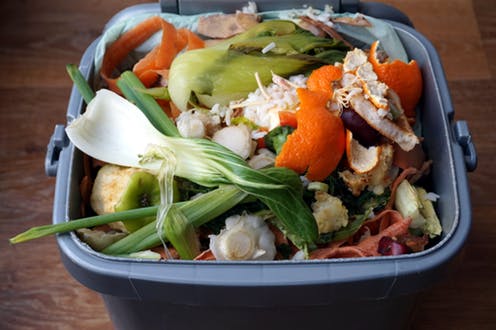Surprise! Food Waste is Impacting Our Planet

Courtesy of The Conversationalist
Several waste-bins look like this after buying fresh produce that isn’t consumed in time.
If food waste were a country, it’d be the third largest greenhouse gas emitting country in the world.
According to the U.S. Environmental Protection Agency (EPA), about ninety-four percent of food gets thrown away in the United States. Globally? Reset says that an estimated 1.3 billon tons of food (or one-third of food produced) is wasted globally each year.
What is “food waste?” By definition, food waste refers to products that are fit for human consumption but are thrown away. It can originate from a variety of different situations: all-you-can-eat buffets, buy-one-get-one deals, stores, schools, restaurants, kitchen homes – simply consuming more food than needed. It’s a dire problem that stems from the plainest situations, an issue that not only affects the amount of garbage in our waste-bins, but the health of our planet.
When food is thrown away, it throws away the energy, water, and resources used to grow it. The food is left to rot in landfills, its nutrients within it never returning to the soil. While rotting, the product creates methane gas: a greenhouse gas that is at least twenty-eight times more potent than carbon dioxide.
How often do you stare at what’s inside your refrigerator, feeling as if there’s no food to eat but in reality there are several things to eat? This is a common occurrence for many people, and it’s also a common way food is left to rot and be uneaten. Making a game plan or a list of food “necessities” is an easy way to combat food waste. This allows you to buy the foods you eat the most frequently, reducing the amount of uneaten food that spoils (and is later thrown away).
We all consume food; we need it to survive – and yet, we are still wasting enough food that can satisfy all people suffering from starvation worldwide. Why is this so?
As climate change is becoming a bigger and bigger problem for human civilization – one that people have become increasingly aware of – reducing food waste is one of the easiest ways to help lessen our impact on the planet; but, how exactly do we execute this practice?
Frozen foods are another great way to reduce food waste, as they don’t spoil at the same rate as fresh foods. Fruits and veggies that are frozen maintain most of the same nutrients as well, so it isn’t like your foods are packed with chemicals and preservatives.
Reducing the amount of food you waste isn’t limited to the leftovers on your dinner plate at home; it can be done at school, work, wherever you’re consuming food. What is important is our consciousness on the matter – being conscious of what we put in our shopping carts, and simply making sure that any food we choose to consume doesn’t go to waste. With several people looking for ways to become more sustainable, being aware of the amount of food you throw away is a great way to start. Because food waste is such a dire problem today, one thing is for certain: every effort counts.

EMAIL: [email protected]
Aloha! My name is Gisele Bisch, and I'm from the North Shore. Now a senior this year, I am delighted to say that this is my second year of being a staff member in Ka Mō'ī! I have a profound interest in sustainability, nutrition, drawing and painting, and social justice. As a staff member of Ka Mō'ī, I am fortunate to be able to utilize my student-voice and participate in discussions regarding these and other issues.

